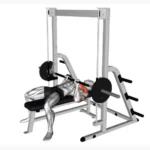Incline Dumbbell Shrug Overview
The incline dumbbell shrug is a targeted exercise designed to strengthen the upper trapezius muscles, whichplay a key role in shoulder stability and posture. Performed face-down on an incline bench, this movementisolates the traps while minimizing involvement of other muscle groups, making it ideal for building a defined,powerful upper back. It also engages the rhomboids and levator scapulae to a lesser extent, supporting overallshoulder health. This exercise is perfect for upper-body workouts, back-focused sessions, or full-body routines,and it’s suitable for beginners and advanced lifters alike. Research highlights that strengthening the traps canimprove performance in exercises like deadlifts and overhead presses by enhancing scapular stability (source:Journal of Strength and Conditioning Research). Additionally, well-developed traps contribute to a broader, morebalanced upper-body appearance. Incorporate incline dumbbell shrugs to boost shoulder strength, correctposture, and enhance functional movements like lifting or carrying.
Incline Dumbbell Shrug Instructions
- Set Up the Bench: Adjust an incline bench to a 30-45 degree angle to ensure proper trap isolation while maintaining comfort. Place the bench in an open area with enough space to hold dumbbells.
- Select Dumbbells: Choose a pair of dumbbells with a weight that challenges you but allows controlled movement. Beginners should start light (e.g., 5-15 lbs per dumbbell) to focus on form.
- Position Your Body: Lie face-down on the incline bench, chest and stomach pressed against the pad, feet flat on the floor or resting on the bench’s support for stability. Engage your core to maintain a neutral spine.
- Grip the Dumbbells: Hold a dumbbell in each hand with a neutral grip (palms facing each other). Let your arms hang straight down toward the floor, fully extended, with a slight bend in your elbows to reduce joint stress.
- Initiate the Shrug: Squeeze your shoulder blades together and lift your shoulders toward your ears, contracting your upper trapezius muscles. Focus on using your traps to drive the movement, not your arms. Hold the contraction for 1-2 seconds to maximize activation.
- Lower the Dumbbells: Slowly return to the starting position, allowing your shoulders to relax fully while keeping the dumbbells under control. Avoid letting the weights pull your arms excessively.
- Repeat: Perform 3 sets of 12-15 reps, resting 60-90 seconds between sets. Focus on smooth, deliberate movements to target the traps effectively.
Incline Dumbbell Shrug Tips
- Isolate the Traps: Focus on lifting your shoulders using only your trapezius muscles. Avoid bending your elbows or pulling with your arms to ensure proper isolation.
- Controlled Tempo: Use a slow, steady motion (e.g., 2 seconds up, 2 seconds down) to increase time under tension and enhance muscle activation, as supported by studies on muscle hypertrophy (source: Sports Medicine).
- Breathing Technique: Exhale as you shrug your shoulders upward and inhale as you lower them to maintain rhythm and core stability.
- Posture Check: Keep your chest pressed against the bench and avoid arching your lower back to prevent strain. Your neck should stay neutral, aligned with your spine.
- Start Light: Begin with lighter weights to perfect form before progressing to heavier loads to avoid overstraining the traps or shoulders.
- Variation Options: Try using a barbell or cables for shrugs, or adjust the bench angle (e.g., 30 vs. 45 degrees) to slightly alter trap engagement.
- Avoid Over-Shrugging: Don’t force your shoulders beyond their natural range of motion to prevent impingement or discomfort.
- Progress Gradually: Increase weight or reps as strength improves, but prioritize form to maximize results and minimize injury risk.
Benefits: The incline dumbbell shrug strengthens the upper trapezius, improves shoulder stability, and enhances posture by counteracting forward shoulder slouch. It supports performance in compound lifts like deadlifts and promotes a broader, more defined upper-back aesthetic. This exercise also aids in reducing neck and shoulder tension from daily activities like sitting or typing.
Building traps with incline shrugs? Learn how they enhance your back in our Ultimate Guide to Muscle Groups.






